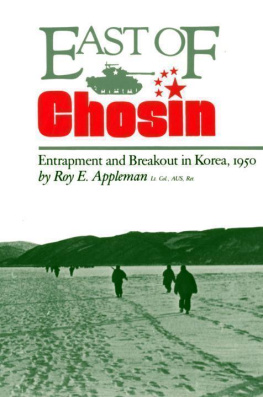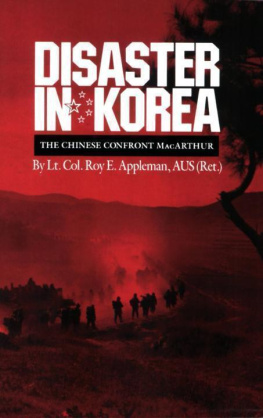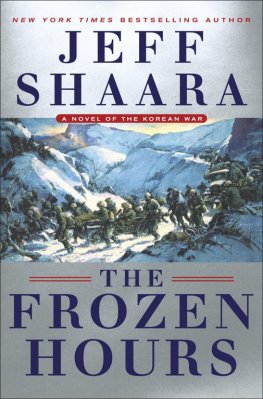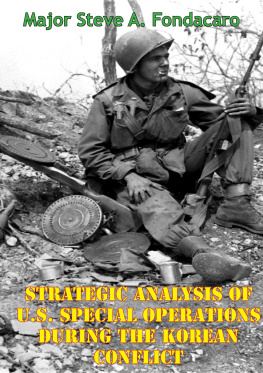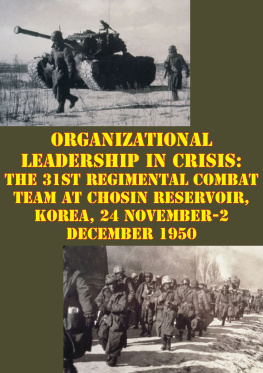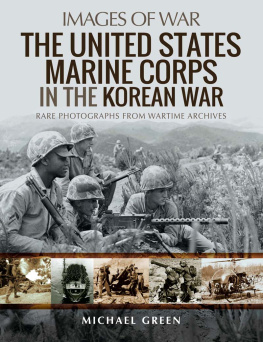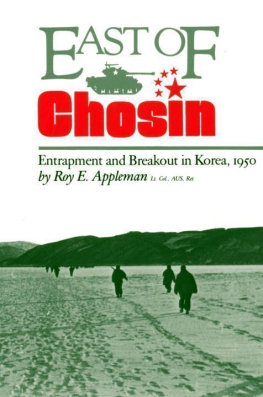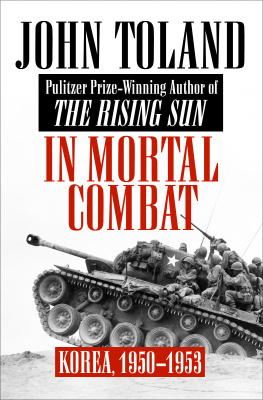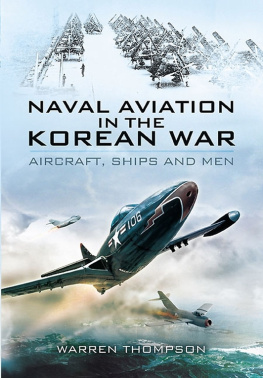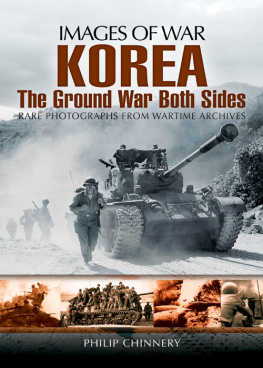Entrapment and Breakout in Korea, 1950 by Roy E. Appleman, Lt. Col., AUS, Ret.




vii
xi
CHAPTER
APPENDIXES
Hagaru-ri, at the South End of Chosin Reservoir
Typical Terrain: Dirt Road, Rice Paddies, Mountains
The Treacherous Road Up Funchilin Pass
Lt. Col. Don C. Faith, Jr., on Maneuvers in Japan
Capt. Robert F. Haynes and Maj. Wesley J. Curtis
Lt. James O. Mortrude
Col. James G. Campbell in 1978
Col. Allan D. MacLean and Lt. Col. Don C. Faith, Jr.
Principal Staff Officers, 1st Battalion, 32nd Infantry
Officers, 1st Battalion, 32nd Infantry, 7th Division
Looking North over the North End of Chosin Reservoir
Col. Crosby P. Miller in 1966
Looking North over Pungnyuri-gang Inlet
Capt. Robert E. Jones
Capt. Edward P. Stamford
Stamford's TACP Members
First Lt. Raymond Vaudreaux
First Lt. Hugh R. May
View within the Inlet Perimeter from an Artillery Position
Capt. James R. McClymont
Capt. James R. McClymont and D Battery Members
Mi9 Full-track (Dual-4o)
M16 Half-track (Quad-So)
View toward Chosin Reservoir from 3rd Battalion Perimeter
View Looking Northwest across the Inlet Perimeter
View Southeast from B Battery Position
Lt. Col. Ivan H. Long about 1965
Capt. Drake, Maj. Gen. Almond, and Maj. Gen. Barr
Maj. Gen. Henry I. Hodes
View of Inlet Perimeter Area Attacked by Chinese
Eastern Inlet Perimeter after the Attack
Panorama of Eastern Inlet Perimeter
Airdrop over the Inlet Perimeter
ist Battalion Crossing the Inlet to the 3rd Battalion
Maj. William R. Lynch and Maj. (Chaplain) Martin C. Hoehn
Aerial View of All Battle Sites near Chosin Reservoir
Capt. Earle H. Jordan, Jr.
Marine Corsair, F4U, in Flight
Task Force Faith in Breakout Attempt
Task Force Faith Survivors on the Reservoir Ice
I Korea
2 U.S. Lines as of November 24, 1g5o, and MacArthur's Plan of Attack
3 Chosin Reservoir
4 X Corps Movements to Chosin Reservoir and Plan of Attack
5 Chinese Troop Movement before November 27
6 31st Regimental Combat Team, Evening of November 27
7 1st Battalion, 32nd Infantry, 7th Division Forward Perimeter
8 3rd Battalion, 31st Infantry, and Batteries A and B, 57th Field Artillery Battalion
q Task Force Faith's Inlet Perimeter
io Situation at the Beginning of the Breakout Attempt
11 The Breakout Attempt
he men of the United States Army who fell on the east side of Chosin (Changjin) Reservoir in the winter of 1950 have no white-marble markers at their final resting places as do thousands of others memorialized in Arlington National Cemetery, in other national cemeteries, and in other lands. They have no markers of any kind-only the fragile link of memory that endures from generation to generation in the recollection of their countrymen who know our nation's history. To preserve this link of memory, there must be recorded a history of the events.
This book tells the neglected story of American soldiers from the US Army's 7th Infantry Division who fought on the east side of Chosin Reservoir in the Korean War. It concerns an Army force of about 3,000 men, of near-regimental size, hastily assembled to protect the east flank of the ist Marine Division at Chosin. They fought a battle that lasted four days and five nights in late November and early December, ig5o. The place was a io-mile stretch of frozen, snow-covered dirt road on the east side of Chosin Reservoir, the adjacent bleak hills and ridges that rose precipitously from the water's edge, and the frozen marshy inlet valleys that drained westward from the eastern mountains through these ridges to the reservoir.
Chosin Reservoir fills an irregular trough of the Changjin River valley at an elevation of 3,870 feet in the mountainous plateau south of Manchuria. The weather in winter is Siberian, with night temperatures that reach - 350 F. In winter darkness comes early to this land, in late November and early December at about 4:30 P.m. Daybreak comes late, at 7:30 to 8:00 A.M.
The Army's battle story at Chosin contains as many "if's" as Kipling's poem. Its hallmarks were misery, soul-crushing cold, privation, exhaustion, heroism, sacrifice, leadership of high merit at times, but, finally, unit and individual disaster. For many it was a lonely death in a distant land. It would be hard to find a more nearly hopeless or more tragic story in American military history. Lieutenant Colonel Don C. Faith, Jr., the final commander of the force, received the Congressional Medal of Honor, Posthumously.
The background of East of Chosin, like a dramatic overture setting the theme for stage action, was Gen. Douglas MacArthur's plan to drive the Communist forces beyond the Yalu River, unify the peninsula, and end the Korean War. He set in motion a last major offensive to accomplish this on November 24, 1950, in the Eighth Army zone of operations, in the west of Korea, and on November 27 in the X Corps zone of operations, in northeast Korea.
Then a mass of soldiers out of China, dressed in quilted, padded uniforms, wearing fur caps, and laden with grenades and automatic burp guns, suddenly appeared before the unsuspecting soldiers in the darkness of night. That was the beginning.
When I began to research what happened east of Chosin, I had in mind only a chapter in a book on the X Corps operations in northeast Korea in the fall and winter of 195o -the X Corps's part in MacArthur's effort to end the war. But in the records in the National Archives, at the Federal Records Center, in Suitland, Maryland, I found no operational journals, no unit histories of those who fought east of Chosin. There was a 7th Infantry Division Special Report on Chosin Reservoir, undated but signed by Maj. Gen. Claude B. Ferenbaugh, who had assumed command of the division on January 26,1951. The report had been prepared by unnamed persons some months after the events related and was fragmentary and unreliable. There was one other document, a 7th Division Action Report, which was nearly barren regarding the units east of Chosin. But attached to this report were a few memorandums and affidavits by Army survivors at Chosin who had reached Hagaru-ri, at the south end of the reservoir, written there a day or two after their escape. The most important of these documents was a four-page typed report by Maj. Robert E. Jones giving a summary of what he knew, addressed to the G-3 Section (operations section) of the 7th Infantry Division, represented at Hagaru-ri by Maj. William R. Lynch, Jr., and a one-page report by Capt. Robert E. Drake covering his 31st Tank Company.

